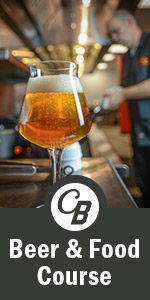Dante may have penned the 9 Circles of Hell in his Devine Comedy “Inferno,” but for craft brewers, the same kind of gauntlet can boil down to a trifecta of annoyances. Well, perhaps annoyance is too strong a word, but there are things you can say to brewers that will make them cringe.
After they get over it, however, they will take the time to explain and educate. For them, that’s the part of brewing that makes it unlike any other occupation — sharing their passion with customers.
(Chart: Your Best Beer and Pizza Style Pairings)
Don’t Say: “Making Craft Beer Must be Easy.”
Mention craft brewing and the uninitiated conjure up an image of a brewer in a tasting room, thinking up cool names for their beer and imagining the art they will use on their label design. The truth is that brewers spend 90 percent of their time slinging bags of grain around, dragging hoses, scrubbing out kettles and mucking out spent grain and hops.
“I think a lot of customers see these highly-automated breweries where you push a button and things just go and assume that’s how it works,” Chris Price, head brewer/owner at Dissent Brewing Company in Saint Petersburg, Florida, says. “They don’t realize that some poor guy, most likely me, has lugged around 55-pound bags of malt, manually stirred the mash, cleaned and labored in the 90-plus degree heat and humidity for hours on end to create the beer they are enjoying in the comforts of the air-conditioned taproom.”
(9 Venues That Prove You Can’t Beat a Brewery Wedding)
Hopsters Brewing Company in Newton, Massachusetts, has found the solution for this common brewer’s dilemma; they let people brew their own beer onsite, according to Christian Mosebach, head brewer. They have 10 15-gallon kettles in the middle of their taproom. With the help of a Hopsters brewer, customers learn to brew three cases of their own craft beer from extract. They even design their labels to use when they return two to three weeks after their beer has fermented and is ready to bottle.
Mosebach agrees that customers might not be aware how much cleaning, sanitizing and upkeep it takes to brew beer.
“We have a fun atmosphere,” Mosebach says. “They may think that all you do is put in the ingredients and you get beer. We’ll coach them through the process and let them know what goes into making beer, and hopefully, that clicks.”
Don’t Say: “I Drink Craft Beer — ‘Shock Moon’ is My Favorite.”
Jeff Hansen at Wildcard Brewing Company in Redding, California, says theirs was the first of three local breweries to open in a town of 100,00 people. In short, he says, there’s good craft beer in Redding. But, it still unsettles him how many locals think drinking a label from a Big Beer company qualifies as a craft beer experience.
“My customers are always surprised when I inform them that the Shock Top or Blue Moon they are drinking at home are not really craft beers,” says Hansen. “I find when you explain that to customers, they really care about the ownership. They want to support the men and women who took a chance and quit their jobs to make good beer in their community.”
Hansen notes that with big beer companies buying regional and even national craft brewers (think, he said, of Constellation Brands, owners of Corona, buying Ballast Brewing, and Heineken buying Lagunitas) ownership is not always disclosed transparently. The Brewers Association, publishers of CraftBeer.com, define a craft brewer as small, independently owned, and one that uses traditional ingredients. Brewers everywhere report that such misunderstanding around this issue is not uncommon.
(What Is the Independent Craft Brewer Seal?)
According to Garrett Oliver, brewmaster at Brooklyn Brewery in New York, there is a growing realization that craft beer equals better beer.
“I’m glad that the general public cares a lot more about beer than they used to. It certainly wasn’t always boom times in the past, and craft brewers were once thought of by most people as boys playing with toys,” he says. “Now this is seen as a respected profession, as it always should have been. It’s fun, but it’s not easy, so we take it very seriously.”
And then there is the matter of pumpkin beer – the Gordian Knot, it seems, – of craft brewing. You either love it or hate it, but some brewers will confess they would be happy not to make it if their customers didn’t ask for it. Mosebach, with Hopsters, recalls an exchange at a former brewery. They had made an Oktoberfest and tank laagered it for six weeks, and he was really proud of it.
“A customer took a sip and said, ‘Yes that it is good — I can taste the pumpkin in it,'” Mosebach recalls, laughing about it now. “It really rubbed me the wrong way, because there’s no pumpkin in Oktoberfest. I just had to walk away.”
Don’t Say: “Craft Beer is Bitter.”
Thanks to the proliferation of rice-based big beers that dominated the market for decades, brewers have a bit of an ongoing job cut out for them: to change preferences. That fizzy yellow liquid that passed for beer for so long in the U.S. can be an obstacle for the taste buds to the variety and quality of selection offered by craft brewers.
“People think rice is a basic ingredient of beer because that’s what they see on the label of the big beers,” explains Mosebach.
Price, who tells us he’s heard customers pronounce that craft beer is “bitter,” said they work hard to finish their craft beer into a smooth, unique experience. Dissent Brewing Company hand finishes their beers in batches, combining beers and flavoring in “The Cellar,” a mixing room.
(Dogfish Head Demolishes Original Brewpub)
“By far the least appreciated aspect of brewing is what happens in the cellar,” he explains. “To the general public, the guy or gal stirring the mash gets all the glory, but the real sex symbol of what we do…(is)…in…the cellar. They fix a lot of flaws coming out of the brewhouse and play a huge role in shaping, blending and crafting our Outspoken Ales.” 
According to Oliver with Brooklyn Brewing, the average person knows little about how beer is made — and he said that’s fair. He’s glad that people are now taking a greater interest. Customers are surprised to see the enormous variety of flavors that brewers can create.
“The main thing I want people to realize is that beer is a highly versatile drink,” says Oliver. “It can be bitter, sweet, fruity, acidic, smoky, chocolaty, or even salty. Beer can do everything. No other drink can do what beer can.”
He added that most people think that wine is overall the best pairing beverage for food. But, he says, wine will almost always lose to craft beer in head-to-head culinary competitions.
In the end, being a brewer is about promoting brewing and being open to customers’ curiosity.
“One of our founding principles is of community, and a big part of that is education. We built our brewery around an open concept to bring people into the brewery so that they could be a part of whatever it is we are doing,” says Price. “Both myself and my partner … emphasize that the only dumb question is the one you didn’t ask.”
CraftBeer.com is fully dedicated to small and independent U.S. breweries. We are published by the Brewers Association, the not-for-profit trade group dedicated to promoting and protecting America’s small and independent craft brewers. Stories and opinions shared on CraftBeer.com do not imply endorsement by or positions taken by the Brewers Association or its members.


Share Post